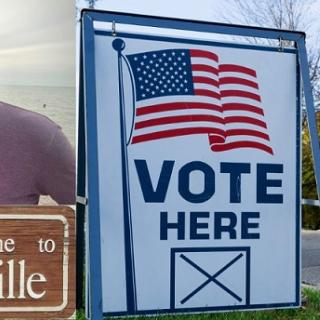The Waldos, the 1970s, Lobby Day, Adult Use
Happy 4/20 or 420, as it is known!! The famed cannaholiday is upon us once again! It’s been over 50 years since five Southern California teens coined the term. While it is ubiquitous today – a codeword for friendship and fun – 420 was a product of its times, a tactic to evade parents, police, and prohibition. Read more below.
Don’t forget The People’s Cannabis Lobby Day at the Ohio Statehouse on Thursday, 4/20. Find out more here.
FOUNDERS of 420 – the WALDOS!
From Mary Jane’s Guide: 4/20/2022 (paraphrased). In 1971, five students at San Rafael High School in California coined the term “420” to connote a “Waldo Safari” search for a cannabis crop near the Point Reyes Peninsula. Naming themselves for their "wall outside the school" hangout, the five students (Steve Capper, Dave Reddix, Jeffrey Noel, Larry Schwartz, and Mark Gravich) designated the Louis Pasteur statue on school grounds as their meeting place and 4:20 pm as their meeting time. The Waldos initially called the plan "4:20 Louis," but eventually shortened it to "420". The term then became a code for getting high unbeknownst to teachers and parents. Today, 420 has become ubiquitous as evidenced by the hundreds of thousands who will attend global events held in its honor, this year on Thursday, 4/20/2023 at 4:20 (am and pm). Read more about the Waldos here and their Oxford English Dictionary accounting of 420 history here. Documented proof that they invented the term can be found here.
420 – A HISTORICAL PERSPECTIVE
The story behind the Waldos and 420 still resonates today. Although these five friends hailed from the San Francisco Bay area during the early 1970s, their 420 experience had a look and feel common to Baby Boomers nationwide. The Waldos prided themselves on their antics and their humor. However, similar pranks, jokes, and codewords for cannabis could be found among the youth in many American small towns and large cities. Waldo “Safaris” (adventurous road trips to smoke weed) might be coined “fry runs,” “tea parties” or a host of other counterculture terms.
The Waldos exemplified the early 1970s. Their proximity to San Francisco made for easy immersion into the “hippie” culture. Their signature garb festooned long hair (men and women), floppy hats, and earthy, western style clothing. The Grateful Dead played the background music in person! (Lucky Waldos!) Other tunes blaring from eight-track tape players included New Riders of the Purple Sage, Captain Beyond, ZZ Top, Yes, Van Morrison, Jefferson Airplane, Santana, Doobie Brothers, Jesse Colin Young, Traffic, Allman Brothers Band, Marshall Tucker Band, Led Zeppelin, Creedence Clearwater, The Who, Chicago, Waylon Jennings, Asleep at the Wheel, and more, even in rural Ohio.
The oftentimes scarcity of pipes and rolling papers meant that, like the Waldos, cannabis consumers had to be inventive. Smoking apparati became Coke cans, toilet paper rolls, tin foil, or if you were lucky, plastic tubing and beakers from the science students.
Mirroring San Francisco, home of the peace and love movement, young people of the 1970s prided themselves on inventiveness, tolerance, kindness and sharing, with a motto of “do anything you want as long as you’re not hurting anybody else.”
Even with such a kind colorful culture, the hippies had enemies. President Richard Nixon, for one. The same year as the Waldos smoke filled Safaris, Nixon launched the War on Drugs. As his aide John Ehrlichman confessed in an interview two decades later, “… by getting the public to associate the hippies with marijuana and blacks with heroin, and then criminalizing both heavily, we could disrupt those communities. We could arrest their leaders, raid their homes, break up their meetings, and vilify them night after night on the evening news.”
Marijuana was very illegal in the 1970s, and the consequences of getting caught were very real. At the time, a first-time possession offense could result in a minimum of two to ten years prison sentence and a fine of up to $20,000. In the 1980s, Congress enacted a three-strikes law, which codified mandatory 25-year prison sentences for repeated serious crimes – including certain marijuana offenses.
Smoking, transporting, selling, buying, hiding, and even just talking about cannabis had to be coded and clandestine, lest one end up like the famed John Sinclair. The “leftist” Michigan activist received a sentence of 8½ to 10 year in prison in 1967 for giving two joints to an undercover cop. Consequently, as the Waldos put it, “the air was charged with danger and lookouts were needed. At any sudden moment you might have to run from the law or authority, or use your wits to quickly outsmart.”
The combination of the 420 codeword and the consequences of marijuana possession ultimately begat the holiday celebrated today. Under the proverbial 420 umbrella, aficionados could gather in numbers and thwart police interference. And as demonstrated by John Sinclair, they could also change cannabis penalties. Shortly after the Ann Arbor Freedom Rally in 1971 (now the annual Hash Bash), the town’s city council lowered possession punishments to just $5. Most certainly, 420 gatherings, now ubiquitous, have been instrumental in developing the quasi-legal environment we enjoy today.
So on 4/20/2023, smoke your joints, hit your bongs, chew your gummies, inhale your vape pens, eat your edibles, rub on your topicals, and do your dabs. All the while, remember that partaking was not always this easy, nor was cannabis always that plentiful. Once upon a time, long long ago, 420 was just a number.
PEOPLE’s CANNABIS LOBBY DAY 2023
A day of support for cannabis reform in Ohio. Sponsored by the Sensible Movement Coalition. Thursday, April 20, 2022 – 9am to 3pm at the Ohio Statehouse in downtown Columbus. Event includes meetings with legislators and speakers on topics like pending legislation, criminal justice reform, decrim movement, and more. Sponsorships are available. Networking opportunities include a rally on the statehouse steps and a 4:20 “smoke out.”
INITIATED STATUTE – SECOND ROUND of SIGNATURES
In the haze of 420, let’s not forget the pending initiated statute to legalize adult use marijuana in Ohio called Regulate Marijuana Like Alcohol (RMLA). Per a legal agreement reached in May 2022, the first set of 136,729 valid signatures collected for the statute count. As required, Secretary of State LaRose then resubmitted the measure to the Ohio General Assembly on 1/5/23. The legislature has four months to pass it. If it fails, the campaign can recommence its drive on 5/5/23 to collect the remaining 132,877 signatures, with a looming 7/5/23 deadline for placement on the ballot in the fall 2023 general election. There is no evidence on the General Assembly’s website that enabling legislation for the statute has been introduced. Key points concerning this proposed law can be found here. If interested in getting involved, contact the campaign here.
=-=-=-=
Mary Jane Borden is a best-selling author, talented artist, and award-winning cannabis activist from Westerville, Ohio. During her 40-year career in drug policy, she co-founded seven cannabis-oriented groups, co-authored four proposed constitutional amendments, lobbied for six medical marijuana bills, penned 100+ Columbus Free Press articles and has given hundreds of media interviews. Her artwork can be viewed at CannabinArt.com and she can be reached at maryjaneborden@ gmail.com.



